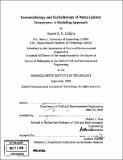| dc.contributor.advisor | Rafael L. Bras. | en_US |
| dc.contributor.author | Collins, Daniel B. G. (Daniel Benjamin Gardiner), 1976- | en_US |
| dc.contributor.other | Massachusetts Institute of Technology. Dept. of Civil and Environmental Engineering. | en_US |
| dc.date.accessioned | 2007-08-29T20:28:15Z | |
| dc.date.available | 2007-08-29T20:28:15Z | |
| dc.date.copyright | 2006 | en_US |
| dc.date.issued | 2006 | en_US |
| dc.identifier.uri | http://hdl.handle.net/1721.1/38559 | |
| dc.description | Thesis (Ph. D.)--Massachusetts Institute of Technology, Dept. of Civil and Environmental Engineering, 2006. | en_US |
| dc.description | Includes bibliographical references (p. 117-129). | en_US |
| dc.description.abstract | The role of vegetation in shaping landforms and how these landforms respond to disturbances are the subjects of this work. A numerical model is developed to help develop a mechanistic understanding of the hydrological, ecological and geomorphic interactions in water-limited ecosystems. The growth of vegetation suppresses increases in runoff, thus reducing erosion efficiency and increasing topographic slopes as rainfall increases in dry climates. Moving along a climatic gradient to wetter climates leads to the point where the effect of vegetation is overwhelmed by increasing runoff, thus erosion efficiency increases and slopes decrease. This transition in vegetation controls translates into a minimum in drainage density for a semi-arid climate. Erosion efficiency is also affected by down-slope increases in vegetation, fostered by subsurface flow, an effect that reduces channel concavity. Plant characteristics also play a role in erosion by changing the variability of the vegetative effects. Comparing regions with the same fractional vegetation cover, those with faster growing or deeper rooted plants have greater erosion efficiencies. | en_US |
| dc.description.abstract | (cont.) The landforms' responses to disturbances depend largely on the recovery time, which in turn depends on the climate and successional characteristics of the vegetation. The erosional response to sustained changes in mean annual rainfall depends on the magnitude and direction of the change as well as on the mean rainfall prior to the change. This means that landscapes most sensitive to erosion differ depending on whether rainfall increases or decreases. Hence, a landscape's sensitivity to erosion is a function of present state as well as change in climate. A second model explores the ecohydrological determinants of plant rooting strategies. Emphasis was placed on soil moisture, and on the factors that govern moisture availability. Results are consistent with observations, and show how rooting depth may respond to environmental factors that determine infiltration depth. Roots are deeper in coarser soils, and in wetter and cooler climates. For a given total rainfall, roots are deeper also where storms are shorter and more frequent. | en_US |
| dc.description.statementofresponsibility | by Daniel B.G. Collins. | en_US |
| dc.format.extent | 129 p. | en_US |
| dc.language.iso | eng | en_US |
| dc.publisher | Massachusetts Institute of Technology | en_US |
| dc.rights | M.I.T. theses are protected by copyright. They may be viewed from this source for any purpose, but reproduction or distribution in any format is prohibited without written permission. See provided URL for inquiries about permission. | en_US |
| dc.rights.uri | http://dspace.mit.edu/handle/1721.1/7582 | |
| dc.subject | Civil and Environmental Engineering. | en_US |
| dc.title | Geomorphology and ecohydrology of water-limited ecosystems : a modeling approach | en_US |
| dc.type | Thesis | en_US |
| dc.description.degree | Ph.D. | en_US |
| dc.contributor.department | Massachusetts Institute of Technology. Department of Civil and Environmental Engineering | |
| dc.identifier.oclc | 150458527 | en_US |
